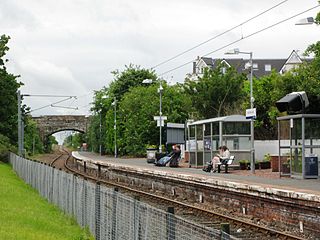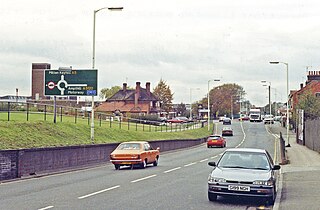
St Albans Abbey railway station in St Albans, Hertfordshire, England is about 0.6 miles (1 km) south of the city centre in the St Stephen's area. It is the terminus of the Abbey Line from Watford Junction, operated by London Northwestern Railway. It is one of two stations in St Albans, the other being the much larger and busier St Albans City.

Leighton Buzzard railway station serves the towns of Leighton Buzzard and Linslade in the county of Bedfordshire and nearby areas of Buckinghamshire. Actually situated in Linslade, the station is 40 miles (64 km) north west of London Euston and is served by London Northwestern Railway services on the West Coast Main Line. Until the 1960s the station was the start of a branch to Dunstable and Luton, with a junction just north of the present station. The station has four platforms. Platforms 1 & 2 serve the fast lines and are used by Avanti West Coast services running non-stop to/from London Euston. Platforms 3 & 4 are served by slower London Northwestern railway services to/from London Euston.

Luton Airport Parkway railway station is on the Midland Main Line in England, serving south Luton and Luton Airport in Bedfordshire. The station is situated in Luton's Park Town district, being 29.27 miles (47.11 km) from London St Pancras between Harpenden to the south and Luton to the north. Its three-letter station code is LTN, also the IATA code for the airport.

Luton railway station is located in the town centre of Luton, Bedfordshire, England. The station is about three minutes' walk from The Mall Shopping Centre. It is situated on the Midland Main Line and is operated by Thameslink.

North Berwick railway station is a railway station serving the seaside town of North Berwick in East Lothian, Scotland. It is the terminus of the Edinburgh to North Berwick Line, 22+1⁄4 miles (35.8 km) east of Edinburgh Waverley.

Harpenden railway station is on the Midland Main Line in England, serving the town of Harpenden, Hertfordshire. It is 24 miles 51 chains (39.7 km) down the line from London St Pancras and is situated between St Albans City to the south and Luton Airport Parkway to the north. Its three-letter station code is HPD.

Dunstable Town, also known as Dunstable Church Street, was a railway station on the Great Northern Railway's branch line from Welwyn which served Dunstable in Bedfordshire from 1858 to 1965. Against a background of falling passenger numbers and declining freight returns, the station closed to passengers in 1965 and to goods in 1964, a casualty of the Beeching Axe. The station site is now in use as part of the Luton to Dunstable Busway.
Harpenden East was one of two stations serving the town of Harpenden, the other station which remains open being Harpenden Central. Originally named Harpenden, the East suffix was added in 1950 to distinguish it from the Midland Railway station.

Chiltern Green railway station was built by the Midland Railway in 1868 on its extension to St. Pancras.

Luton Bute Street railway station was the first to be built in Luton, England. It was opened by the Luton, Dunstable and Welwyn Junction Railway Company in 1858, which was an extension of the Welwyn and Hertford Railway. The track to Welwyn was completed in 1860 and taken over by the Great Northern the following year.
Rhuddlan was a railway station located in Rhuddlan, Denbighshire. It first opened in 1858 as part of the Vale of Clwyd Railway, and afterwards under the auspices of several different companies. The station closed to passengers on 19 September 1955, some seven years after nationalisation.
Newport Mill Street railway station was one of four stations in central Newport, Wales.

Staple Hill railway station was on the Midland Railway line between Bristol and Gloucester on the outskirts of Bristol. The station was on the Bristol and Gloucester Railway line, but opened in 1888, 44 years after the line had been opened through the site. It served the Victorian suburban developments in the area to the south of Mangotsfield.

The Dunstable Branch Lines were railway branch lines that joined the English town of Dunstable to the main lines at Leighton Buzzard and Welwyn. The two lines were under separate ownership and joined just east of the Dunstable North station.
Stanbridgeford railway station on the London and North Western Railway's branch line to Dunstable served the Bedfordshire villages of Stanbridge, Totternhoe, Eaton Bray and Tilsworth from 1849 to 1964. Once popular with visitors to the nearby Totternhoe Knolls and ramblers, the station closed against a background of falling passenger numbers and declining freight returns. The station building has survived into private ownership, but a section of the alignment to the east and west of the site has been taken into the A505 Leighton Southern Bypass. National Cycle Network route 6 runs to the east over the bypass as far as the outskirts of Dunstable.

Dunstable North was a railway station on the London and North Western Railway's branch line from Leighton Buzzard which served Dunstable in Bedfordshire from 1848 to 1967. Originally the terminus of the London and North Western Railway's branch line from Leighton Buzzard, Dunstable became the point where the line met with the Great Northern's branch line from Luton in 1858. The station became the hub of a number of sidings connecting a variety of concerns to the line, including Waterlows, Bedfordshire County Council, Associated Portland Cement, Dunstable gasworks and a coal yard operated by the Great Northern. Against a background of falling passenger numbers and declining freight returns, the station closed to passengers in 1965 and to goods in 1967. Connections were retained with the cement works and coal yard, which became an oil depot, until 1988 and the line eventually closed in 1991. The site of the station is now occupied by offices of Central Bedfordshire Council. A section of the former line to the west of the site has become part of route 6 of the National Cycle Network.

Wheathampstead railway station was a railway station serving Wheathampstead on the Great Northern Railway branch line to Dunstable. While little of it remains now, east of Wheathampstead is the Ayot Greenway which follows what was the line towards Welwyn Garden City.
New Mill End is a hamlet in Central Bedfordshire, England, close to the Bedfordshire county border with Hertfordshire. It is in the civil parish of Hyde, 3 miles (4.8 km) south east of Luton on the B653 road to Wheathampstead.

Chaul End was a temporary railway halt on the Great Northern Railway's branch line from Welwyn which served a munitions factory near Luton during the First World War. The station site has been reused as part of the Luton to Dunstable Busway.
The Hertford, Luton and Dunstable Railway was a railway affiliated to the Great Northern Railway. It was formed when the Hertford and Welwyn Junction Railway merged with the Luton, Dunstable and Welwyn Junction Railway, partly opened in the same year. The merger and change of title took place in 1860. The line joined the Dunstable branch of the London and North Western Railway at Dunstable.














